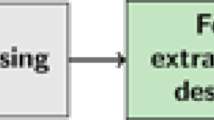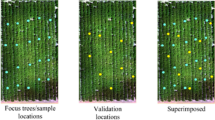Abstract
This paper presents an approach to segment the light microscopic images of hardwood species and then extract only the vessel elements out of the images. In this work, an effort was made to propose a platform-independent tool based on simple digital image processing technique to quantify wood conduits (especially vessel elements at present). A prototype model was developed and tested on several microscopic images prepared at the xylarium (DDw) of the Wood Anatomy Discipline of the Forest Research Institute, Dehradun, India. The investigation of the experimental work suggests that for most of the images, with the help of appropriate parameter selection, the vessel elements were extracted. In one case, the identified vessel element area was in fact the area of vessel element plus the surrounding parenchyma elements area. Close observation of the aforementioned object in original color (RGB) image suggests that the parenchyma elements surrounding the vessel elements have higher intensity level, in contrast to other parenchyma elements. This happened because an intensity-based thresholding approach was used for converting an RGB image to a binary image. Further, along with the extraction of vessel elements, the proposed model is capable of computing the hydraulic conductivity and lumen resistivity of the vessel elements.




Similar content being viewed by others
References
Baas P (1976) Some functional and adaptive aspects of vessel member morphology. Leiden Bot Ser 3:157–181
Baas P, Werker E, Fahn A (1983) Some ecological trends in vessel characters. IAWA Bull 4:141–159
Bond B (2002) Wood identification for hardwood and softwood species native to Tennessee, Agricultural Extension Service, University of Tennessee
Carlquist S (1980) Further concepts in ecological wood anatomy, with comments on recent work in wood anatomy and evolution. J Syst Evol Bot 9:499–553
Carlquist S (2013) Comparative wood anatomy: systematic, ecological, and evolutionary aspects of dicotyledon wood. Springer, Berlin
Davis SD, Sperry JS, Hacke UG (1999) The relationship between xylem conduit diameter and cavitation caused by freezing. Am J Bot 86:1367–1372
Dettmann S, Pérez CA, Thomas FM (2013) Xylem anatomy and calculated hydraulic conductance of four Nothofagus species with contrasting distribution in South-Central Chile. Trees 27:685–696
Dutta S, Pal S, Mukhopadhyay S, Sen R (2013) Application of digital image processing in tool condition monitoring: a review. CIRP J Manuf Sci Technol 6:212–232
Guijarro M, Pajares G, Riomoros I, Herrera P, Burgos-Artizzu X, Ribeiro A (2011) Automatic segmentation of relevant textures in agricultural images. Comput Electron Agric 75:75–83
Hacke UG, Sperry JS, Pittermann J (2005) Efficiency versus safety tradeoffs for water conduction in angiosperm vessels versus gymnosperm tracheids. In: Vascular transport in plants. Elsevier, Amsterdam, pp 333–353
Kanan C, Cottrell GW (2012) Color-to-grayscale: does the method matter in image recognition? PLoS ONE 7(1):297401–299740
Lens F, Luteyn JL, Smets E, Jansen S (2004) Ecological trends in the wood anatomy of Vaccinioideae (Ericaceae sl). Flora 199:309–319
Lewis AM (1992) Measuring the hydraulic diameter of a pore or conduit. Am J Bot 79:1158–1161
Martínez-Cabrera HI, Jones CS, Espino S, Schenk HJ (2009) Wood anatomy and wood density in shrubs: responses to varying aridity along transcontinental transects. Am J Bot 96:1388–1398
Mencuccini M, Martinez-Vilalta J, Piñol J, Loepfe L, Burnat M, Alvarez X, Camacho J, Gil D (2010) A quantitative and statistically robust method for the determination of xylem conduit spatial distribution. Am J Bot 97:1247–1259
Min T-H, Park R-H (2009) Eyelid and eyelash detection method in the normalized iris image using the parabolic Hough model and Otsu’s thresholding method. Pattern Recognit Lett 30:1138–1143
Otsu N (1979) A threshold selection method from gray-level histograms. IEEE Trans Syst Man Cybern 9:62–66
Pan S, Kudo M (2011) Segmentation of pores in wood microscopic images based on mathematical morphology with a variable structuring element. Comput Electron Agric 75:250–260
Poorter L (2008) The relationships of wood, gas and water fractions of tree stems to performance and life history variation in tropical trees. Ann Bot 102:367–375
Qi H-n, Chen F-n, Wang H-j (2008) Analysis of quantitative pore features based on mathematical morphology. For Stud China 10:193–198
Rzepecki A, Thomas F (2017) A new Fiji-plugin for visualizing intra-annual density fluctuations and analyzing intra-annual theoretical volumetric flow rate fluctuations along wood cross-sections. Dendrochronologia 44:58–65
Rzepecki A, Zeng F, Thomas F (2011) Xylem anatomy and hydraulic conductivity of three co-occurring desert phreatophytes. J Arid Environ 75:338–345
Scholz A, Klepsch M, Karimi Z, Jansen S (2013) How to quantify conduits in wood? Front Plant Sci 4(56):1–11
Sobel I (1972) Camera models and machine perception. DTIC Document, Stanford University, Palo Alto, California, 1970
Sperry JS, Sullivan JE (1992) Xylem embolism in response to freeze-thaw cycles and water stress in ring-porous, diffuse-porous, and conifer species. Plant Physiol 100:605–613
Sperry JS, Nichols KL, Sullivan JE, Eastlack SE (1994) Xylem embolism in ring-porous, diffuse-porous, and coniferous trees of northern Utah and interior Alaska. Ecology 75:1736–1752
Tyree MT, Zimmermann MH (2002) Xylem structure and the ascent of sap, 2nd edn. Springer, Berlin
Umeh LI, Omoluabi C, Salleh MN, Prins C, Tomaselli I, Abdel Nour HO, Dombeck M, Moad A, Sayer JA (2001) Forests and the future: regional perspectives. Unasylva (English ed) 52:33–52
Van Oosten C (2013) Restoring landscapes—Governing place: a learning approach to forest landscape restoration. J Sustain For 32:659–676
Von Arx G, Carrer M (2014) ROXAS: a new tool to build centuries-long tracheid-lumen chronologies in conifers. Dendrochronologia 32:290–293
Von Arx G, Kueffer C, Fonti P (2013) Quantifying plasticity in vessel grouping–added value from the image analysis tool ROXAS. IAWA J 34:433–445
Wang H, Qi H, Li W, Zhang G, Wang P (2009) A GA-based automatic pore segmentation algorithm. In: Proceedings of the first ACM/sigevo summit on genetic and evolutionary computation. ACM, pp 985–988
Wegner L, Von Arx G, Sass-Klaassen U, Eilmann B (2013) ROXAS: an efficient and accurate tool to detect vessels in diffuse-porous species. IAWA J 34:425–432
Wheeler EA, Baas P (1998) Wood identification: a review. IAWA J (Netherlands) 19:241–264
Yadav AR, Anand RS, Dewal ML, Gupta S (2015) Classification of Hardwood species using multiresolution feature extraction techniques. Dissertation, ©Indian Institute of Technology Roorkee
Yadav AR, Anand RS, Dewal ML, Gupta S (2017) Binary wavelet transform-based completed local binary pattern texture descriptors for classification of microscopic images of hardwood species. Wood Sci Technol 51:909–927
Yu H, Liu Y, Han G, Cui Y (2009) Comparison of image analysis and conventional methods for cellular tissue proportion measurement of wood. In: IEEE international conference on information and automation (ICIA’09), pp 133–137
Zimmermann M (1978) Structural requirements for optimal water conduction in tree stems. Cambridge University Press, Cambridge, pp 517–532
Acknowledgement
The authors express their earnest gratitude to Forest Research Institute Dehradun, Dehradun, India, for providing microscopic images of hardwood species for academic research purpose.
Author information
Authors and Affiliations
Corresponding author
Additional information
Publisher's Note
Springer Nature remains neutral with regard to jurisdictional claims in published maps and institutional affiliations.
Rights and permissions
About this article
Cite this article
Yadav, A.R., Anand, R.S., Dewal, M.L. et al. Determination of vessel elements and computation of hydraulic conductance of hardwood species images using digital image processing technique. Wood Sci Technol 53, 1191–1205 (2019). https://doi.org/10.1007/s00226-019-01125-9
Received:
Published:
Issue Date:
DOI: https://doi.org/10.1007/s00226-019-01125-9




